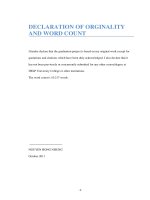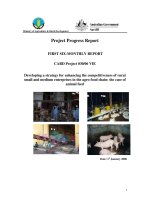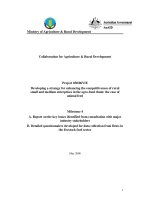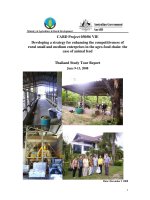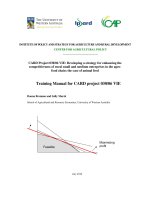Family small and medium enterprises (smes) management how toapply effectively to phu cuong coffe export company
Bạn đang xem bản rút gọn của tài liệu. Xem và tải ngay bản đầy đủ của tài liệu tại đây (29.65 MB, 80 trang )
I
HCMC UNIVERSITY
OF FOREIGN LANGUAGES
TECHNOLOGY
& INFOR1\1ATION
(HUFLIT)
SCHOOL OF FOREIGN LANGUAGES
GRADUATION PAPER
FAMILY SMALL AND MEDlUM
ENTERPRISES (SMEs) MANAGEJ\'IENTHOW TO APPL Y EFFECTIVELY TO PHD
cudNG
COFFEE EXPORT CO~v.IPANY
•
ADVISOR
STUDENT
STUDENT NUMBER
CLASS
ACADEMIC YEAR
: DR.-lNG,
DANG
l'flNH TRANG
1: PHAN NGUYEN HO~ MI
: 0071427
: KA 0001
: 2000-2004
TV Dgi H9C Huflit
11111111111111111111111 II III
101000507
JULY, 2004.
HCMC UNIVERSITY
OF FOREIGN LANGUAGES & lNFORMA nON
TECHNOLOGi
T
(HUFLIT)
SCHOOL OF FOREIGN LANGUAGES
GP.....
t\DUATION PLt\PER
FAMILY SMALL AND MEDIUM
ENTERPRISES (SMEs) MANAGEMENTHOW TO APPLY EFFECTIVELY TO PHU
cudNG
COFFEE EXPORT CO]VIPANY
•
ADVISOR
STUDENT
STUDENT NUMBER
CLASS
ACADEMIC YE~Ai'
: DR.-lNG.
D~NG MINH TRANG
: PHAN NGUYEN HO~ MI
: 0071427
: KA 0001
}lJo;~
~~~~
,C~JF~~r-.
~~}v~7
f
11.;;;;i/
JULY, 2004.
•
EVALUATOR'S ASSESSME~iT
...................................................................................................................................
...................................................................................................................................
...................................................................................................................................
...................................................................................................................................
.
(
•••••••••••••••••••••••••••••••••••
0 •••••••••••••••••••••••••••••••••••••••••••••••••••••••••••••••••••••••••••••••••••••••••••••••
...................................................................................................................................
...................................................................................................................................
...................................................................................................................................
..
~
j
...................................................................................................................................
.
...................................................................................................................................
...................................................................................................................................
~ ...................................................................................................................................
...................................................................................................................................
...................................................................................................................................
...................................................................................................................................
< •.•.•.•••.•.•.••••••.••••••••.•••••••.••••••••••.••.•••••••.••••.•..•.•••••••••••••••.••.••••••••..••••••••••••••••••.•.•••••••••••
(
.
I
i :::::::::::::::::::::::::::::::::::::::::::::::::::::::::
f :::::::::::::::::::::::::::::::::::::::::::::::::::::::::::::::::::::::::::::::::::::::::::::::::::::::::::::::::::::::::::::::::::
~
...................................................................................................................................
...................................................................................................................................
.
ACKNOWLEDGEMENTS
I would like to thanks Mr. D?ng Minh Trang, who is my supervisor, for
all his instructions on this graduation report.
I many thanks to the generous support of Mr. Phan Van D&u, Director of
PM Cuemg Company, who had provided all necessary information about
the company to fullfil this research.
I especially thanks my family members and friends who have given me
.
the encouragement and confident to continuing and finish this graduate
research paper.
July, 2004.
Phan Nguy~nHQa Mi
K~lvtirtt-[hJ
~ilClU
tiuPU'j
r.J JOe, c1::;-. ;] - "uv 4-
;r.~
PREFACE
With the policy of encouraging the development of the private section of the State,
a large number of small and medium enterprises (SME), especially
family
businesses, are increasing day by day, giving more contribution to the country's
economy and society.
It is undeniable the important role of SME to the development of our country. But
this business is now facing many difficulties such as lacking capital, limited
managerial
ability,
competitiveness
under-qualified
technical
conditions
and
limited
that prevent them from running the company effectively and
integrating into the international market. There are limited for SME to expanding
,
to an Incorporation or bigger joint Corporation due to lack of basic management
skills. Solving those problems would thus serve to strengthen this important sector
of the economy.
The aim of this research is to bring theory into reality. However, I am aware that
there is always room for improvement in this research, so I am very happy to
receive any comments in order to make this research better. Many thanks.
July, 2004.
PURPOSE OF THE RESEARCH
The study focuses on the advantages and disadvantages of family
SME. From this, some suggestions have been made to run the
family
SME
effectively
such
as
good
managers,
team
construction and successful successor planning. The next section
of the research is to focuses to the real situation of PM CUOng
coffee export company. The strengths and weaknesses
of the
company will be analyzed by SWOT analysis method in order to
set planning
for business growing. Therefore, this study may
serve as a manual for the managers of family SME.
TABLE OF CONTENT
Chapter
1: An overview on family small and medium enterprises
Vi et Nam ..
IO ••••••••••••••••••••••••••••
10 •••••••••••••••••••••••
1. The development
(SME) in
10 •••••••••••••••••••••••••••••••••••••••••••••••••••••
and real state ofSME in Viet Nam
2. Definition of family SME
1
10
2
3
2.1 Definition of family business
3
2.2 Definitio n of SME
4
2.3 Definition of family SME in Viet Nam
5
3. Characteristic
of family SME
6
3.1 Establish men t
6
3.2 Ownership and management
6
3.3 Human resou rces
6
3.4 Inter-relation
7
4. Advantages
between family and business
and disadvantages
4.1 Advantages
of family SME
of family SME .........................................•......................
;. 8
8
4.1.1 Freedom
8
4.1.2 Finan cia I ben efit
9
4.1.3 Prestige and pride
9
4.1.4 Tightening the family relationships
10
4.1.5 Good relationship
10
between employer and employees
4.1.6 Flexibility in management
4.2 Disadvantages
of family SME
11
;.. 11
4.2.1 Lack of capital
11
4.2.2 Inter-related
12
between family and business
4.2.3 Unclear role definition
12
4.2.4 Unskillful staff
13
4.2.5 Lack of managerial
skills
13
4.2.6 Lack of su ccesso r
Chapter 2: Effective management
1. Competencies
13
of a family company
14
of a good manager ...........................................••...............
1.1 The important
1.2 Competencies
of great boss ...............•.............................................
of a good manager
15
15
16
1.2.1 Lead ership
17
1.2.2 Flexi bility .........................•................................•.......................
17
1.2.3 Creativity ..............................................................................•...
18
1.2.4 Decision making-seizing
19
of opportunities
1.2.5 Self-motivation
20
1.2.6 Risk assessm en t
20
2. B uildin g family team
2.1 The importance
22
of teamwork in an organizational
setting
22
2.2 Behavioral science principle supporting team building ..;••............. 22
2.3 Six characteristics
2.4 Team-building
of an effective work team
guidelines for leaders
2.4.1 C on sid era tion
2.4.2 Stru ctu re ..............................................•.............
24
;
25
25
"...................... 26
2.5 Conflict solving for family team
2.5.1 Ca uses of conflict
2.5.1.1 Poor communication
28
28
skills ...•................................................
28
2.5.1.2 Val ue clash es
29
2.5.1.3 Work policies and practices ......................................•...........
29
2.5.1.4 Adversarial
29
management ..................................................•...
2.5.1.5 No ncomplian ce ....................................................................•.
2.5.1.6 Inter-relations
29
between family and business ....••.................. 30
2.5.2 Key element of conflict resolution
30
2.5.2.1 Attitude adj ustmen t
30
2.5.2.2 An effective leader
31
2.5.2.3 A formal conflict resolution plan ............................•.............
32
3. The succession of a family SME
33
3.1 Family problem in the succession process
33
3.2 The entrepreneurs
of the first generation
34
3.3 The inheritors and successors ....................................................•.....
35
3.4 Factors for a successful succession
36
3.5 How to start dealing with succession
37
3.6 Planning of a successful succession
37
Chapter 3: Phu CU'Ollg coffee export company
39
1. Establish and development process
40
2. Managing structure
41
and working staff of Phu CU'Ollgcompany
2.1 Infrastru cture an d eq uip men t .............................................•............
41
2.1.1
Floor-space ..........................•.........................................................
41
2.1.2
Eq uipmen t ..............................•....................................................
41
2.1.3
Fixed-assets
41
2.2 Working staff and management
42
2.2.1
Organization
42
2.2.2
The analysis of the organization
diagram .............................••..................................
diagram ............•.....................
43
2.2.2.1 Directo r ..•.....................................................•...............................
43
2.2.2.2 Vice-d irecto r .......................•..........................................•.............
43
2.2.2.3 A cco untin g depa rtnl ent...............................................................
44
2.2.2.4 Prod uction departmen t
44
3. State of labor and productivity
45
3.1 The total number of workers of the company
45
3.2 The regulations concerning labor of the company ..............•........... 46
3.3 The state of prod uction .......................................................••............
4. The regulation concerning wages
46
47
4.1 Lead ers
47
4.2 Employees ...................................................................•.....................
47
5. Prod u ctio n process .............................................................................•...
47
5.1 G radin g
5.2 D ryin g..................................................................
49
............•.................
5.3 Packaging and storage
6. The real state of PhD Crrimg company ........•.........................................
49
49
50
6.1 Advantages
50
6.2 Disa dva ntag es
50
6.2.1 Lack of managerial skill
50
6.2.2 Unskillful staff
51
6.2.3 Lack of proper organizational structure
52
6.2.4 Unclear role definition
52
6.2.5 Lack of business strategies
53
6.2.6 Lack of unity of command
;
6.2.7 Lack of successor .....................................................•...................
53
53
Chapter 4: Suggestion to overcome the difficulties and potential for expansion
of Ph tl CU'rrng company
1. SWOT analysis
54
55
1.1 Strengths ..............................................................••........................•..
55
1.2 W eakn esses........................................................................................
55
1.3 Op portu nities
55
1.4 Th rea ts
56
2. Effective planning .......................................•..........................................
56
3. Following th e plan
57
4. Keys to success for Ph" CU'()'ng
59
4.1 Good relationship with suppliers and customers
59
4.2 Com petitive prod uct
59
4.3 In creasing Sales
60
4.4 Tech n 0 logy
60
5. Several suggestions to the manager and family members
5.1 Suggestions to the manager
61
61
5.1.1
Reorganizing
the chart
5.1.2
Effective development of business plan
64
5.1.3
Effective financial management
65
5.1.4
Team construction
66
5.1.5
Policies for family employees
66
5.2 Suggestions to build harmony atmosphere
61
in the business as well as
in the company
67
5.2.1
Building trust
67
5.2.2
Self-disclosu re
68
5.3 Disci plin e
',
69
Ge n era I co nclusi 0 n
7.1
APpen d ix .....•.......................................................................................................
72
P ref ere n ces
]
4
Advisor : D~ng Minh Trang
Chapter 1
CHAPTER ONE
AN OVERVIEW ON FAMILY
SMALL AND MEDIUl'tI
ENTERPRISES (SME) IN VIETNAM
1. The development and real state of SME in Viet Nam
2. Definition of family SME
3. Characteristic
of family SME
4. Advantages and disadvantages
Student:
Phan Nguv~n Roa Mi
of family SME
Chapter 1
However,
Advisor: £)~ng Minh Trang
these enterprises were facing such difficulties as lacking capital,
limited managerial
competitiveness
integrating
ability, under-qualified
technical conditions
and limited
that prevent them from running the company effectively and
into the international
market.
There are limited for SME to
expanding to an Incorporation or bigger joint Corporation due to lack of basic
management
skills. Therefore, the SME will ever stand as where they are on
the business trey and can not be a stock-shares holder.
2. Definition of family SME
To understand the conception of family SME, there are two more concept must
be clarified:
•
What is family business?
•
What is SME?
2.1 Definition of family business
Families can be involved in the business in different ways, and there are many
kinds of family businesses. It is not possible to define clearly just one group of
enterprises that could be labeled as family firms. In order to be called a family
business, a firm needs to fulfill certain conditions: the family needs to retain the
ownership control in the firm, the family needs to be involved in the firm and
the owner-manager
needs to perceive the firm as a family business. The family
can be present - committed to - in the firm.
Generally, a business is considered family-owned
if the family owns 50% or
more of the equity and more than one family member works in the business
(Shanker & Astrachan, 1995). However, some researchers also refer to family
businesses when a member of a founder's family manages the business, after a
succession has taken place, and the family still owns a controlling
interest
(Ibrahim & Ellis, 1994). For purposes of this paper, family businesses will be
defined as those businesses that have two or more family members working in
Student: Phan Nguy6n
HQa Mi
3
Chapter 1
Advisor: £)~ng Minh Trang
the business,
who have financial and managerial
control, and/or an inter-
generational transfer has taken place.
2.2 Definition of SME
There are many definitions of SME that different from countries to countries.
The definition in use depends on the purposes these definitions are required
serve and the policies which govern the SME sector. The three parameters
generally applied by most countries, singly or in combination are:
.:. Capital investment in plant and machinery
.:. Number of workers employed
.:. Volume of production or turnover of business
Now let's take into consideration the definitions of an SME of some countries
in the world and in Viet Nam:
>-
American definition:
One of the early definitions
Department
still widely used is that outlined by the US
of Commerce in 1941. According to this standard, the following
types of firms were considered small business:
Manufacturing
>-
250 employees or fewer
European Commission definition:
Student: Phan Nguy~n
H9a Mi
4
Chapter 1
Advisor: f)~ng Minh Trang
~ Japanese definition:
Sector
Number of employees/Capitalization
Manufacturing,Mining
and others
Not more than 300 employees or Y 100 million
Wholesale
Not more than 100 employees or Y 30 million
Retail and Services
Not more than 50 employees or Y 10 million
»-
Vietnamese definition:
•
Commercial Bank
An SME was an enterprise which had 50 employees or fewer, and a working
capital ofVND 8 billion and anpual revenue ofVND 10 million.
•
Financial Ministry
A business was considered as an SME when it has 100 workers or fewer,
annual revenue of VND 10 billion and VND 1 billion for a registered capital.
•
Economic Experts
An enterprise
was considered
a medium
enterprise
when it has over 50
employees and an investment capital of VND 300 million
•
On 20 June 1998, the government issued a circulation stipulating that "a
business which has a registered capital of VND 5 billion or fewer and
200 contracted workers or fewer is considered as an SME."
In conclusion,
the above conditions to identitY what an SIVIE is should be
widely issued and accepted by Vietnamese businesspersons.
2.3 Definition of Familv SME in Viet Nam:
The Family SME in Viet Nam can be defined as a SME that belonging to one
family which is running by the family members, and usually head of all
operations is the husband and financial in chief is by the wife.
Student: Phan Nguy~n
H9a Mi
5
Chapter 1
Advisor: f)~ng Minh Trang
3. Characteristics of a family SME
3.1 Establishment
The creation of an enterprise in most cases is related to the previous labor
activity of the owner or is a traditional activity of the family.
The creation
phase is characterized
by great expectancies,
by a lot of
administration
procedures and by the necessity to know how to build and how
to assess a business plan. The most crucial period for the survival of the SME,
is the first 2-3 years, because in that period a great effort to get on its foot, to
establish a name and position in the market and to secure internal and external
systems is done. If the above attempt is not handled in a methodical way, the
effort will faIl down and the company is very likely to face obstacle, difficult to
surmount. That's why the mortality rate in new SME is very high.
3.2 Ownership and management
In most case, the managers in family smaIl and medium sized companies are
manager-owners.
This situation
derives
from the fact that one man (the
establisher) undertook the initiative to establish the enterprise, undertaking also
the responsibility and the risk. The qualifications required for managers even in
a smaIl enterprise with limited range of activities are various. An important
factor is also that SME employ a limited number of employees and due to this
managers and employees have to be multi-skilled.
3.3 Human resources
Family firms usuaIly have a low level of qualified staff for two reasons. In the
first place, they prefer to employ family members for managerial positions, and
these members may not be sufficiently
qualified or not have international
experience (GaIlo and Garcia-Pont, 1996). Secondly, family firms usuaIly find
it more difficult to attract professional
managers. The unstructured nature of
these firms, together with the difficulty of fuIly developing
Student: Phan Nguyen
HQa Mi
a professional
6
Chapter 1
Advisor: D~ng Minh Trang
career. in competition
with family members, diminishes the appeal of these
firms to qualified professionals. Existing incentives and promotion systems are
heavily biased toward family members (Lansberg, 1983; James, 1999)
3.4 Inter-relation between familv and business
The main characteristic
of a family SME is the interrelation between family
and business as far as objectives and roie are concerned. The main challenge of
a family SME is to distinguish the roles and do not transfer the conflicts and
problems from the family to the enterprise and vice-versa.
~
The Family System
Families are inward looking; they seek to protect their own. They are emotion
based, i.e. love and that love are unconditional. If a report is not produced in
time by a family member in the business, this does not affect how much the
family loves them. Families share with each other and there is lifetime
membership. Families do not like change and do not respond well to it.
~
The Business System
The business
system on the other hand has different characteristics.
It is
outward looking and task based. It has to be unemotional in its dealings and
rewards performance
Businesses
~
also
based on results. Employees
embrace
and
must perform or leave.
thrive
on
change.
Family Values in the Business
Where the systems overlap, that is, where there is close involvement
of the
family in the management and ownership of the business, there is potential for
conflict.
Student: Phan Nguy~n
HQa Mi
7
Chapter I
Advisor: £)~ng Minh Trang
4.1.2 Financial benefit
Another
advantage
family business
of family business which is not necessarily
is financial benefit. This advantage
limited to
might not be present
initially but usually comes about after a few years when all the loans are paid
off (Rosenblatt 200). Also by paying family members, the money is kept within
the family and is not spread out. Yet, another financial benefit is the profit can
be spread amongst the family members and that reduce the amount of income
tax that is paid.
4.1.3 Prestige and pride
This extra financial leverage brings with it, prestige and pride to some family
business owners. The fact that a person or a family has its own business brings
prestige to them in the community and also pride in the family members. Many
respondents in a survey indicated that they valued intergenerational
continuity
in ownership of a business (Rosenblatt 204). However this might also cause
tension in a family when none of the children want to carry on in the family
business.
Says Heather Leach, associate director of the Family Business Center: "They
are in business for the long haul and they have a vision of what that is," she
says. "They have pride in their products and services and can react to changes
much quicker because there are fewer people and they don't have to go through
levels of red tape."
Some people argue that by having younger members of the family involved in
the family business, they are able to instill good working habits in them at a
young age. It is also a character building activity in the family. This, however,
all depends on how the young family member is treated and coached during his
working presence in the family business.
Student: Phan Nguyen.
HQa Mi
9
Chapter 1
Advisor: D~ng Minh Trang
4.1.4 Tightening the family relationships
There has been some studies show that family relationships between the father
and the son are improved by having a family business and by having younger
members involved in the family business. Imagine a situation when a father
works from morning till night and only gets to see his child at night after a long
day at work. The time they spend together is not the best quality as the father is
really tired a frustrated and the child takes this in a negative manner. But if the
child see his or her father working hard and is by his or her father side, he or
she realizes how much the father cares about them to work hard for the child'
future. Also a mutual respect is created between the child and parent, whether
the child is young or old. The family relationship also improves due to the
better financial standing and by the reduction of stress in the parents' life due to
less pressure from work.
Family members often have a really strong commitment to the family business.
They really want it to succeed. It's not like these employees who say, "Oh, it's 5
o'clock and I'm leaving." They're committed, and they'll be there all night if
need be.
Another real advantage is they put a strong emphasis on relationships. Usually
the family feels the business is an extension of their family, and that means
they want to stand behind what the business does. If we go to an impersonal
company, they'll say, "Sorry, that's business. You should have checked it out
better." But a family will often say it's our reputation and we want to make it
work. So there's often a lot of good will.
4.1.5 Good relationship between employer and employees
The relationship
between the owner-manager
and the employees
in family
company is less formal than that in a large organization. Very often, we see the
boss of a small company and his employees eating and working together. It is
not unusual
for some employees
Student: Phan NguyGn
H9a Mi
to tum to the employer
for advice or
10
Chapter I
Advisor: f)~ng Minh Trang
counseling on their personal or family problems. The employer has to play the
additional role of a friend, a family or marriage counselor, and sometimes and
arbitrator. In some small companies, the owner-manager and the workers know
one another
so well that they are more like friends than employer
and
employees.
4.1.6 Flexibility in Management
Another
fundamental
advantage
of small firms is that they are not so
formalized. They have fewer procedures and less internal paperwork and are
less restrictive in moving from job to job or trying new strategies. Big business
is characterized by its inability to make decisions rapidly or to implement them
quickly once they are made.
The small entrepreneur is relatively free to enter or leave a business, to grow or
contract,
and to succeed
flexibility
to meet
or declare
changing
market,
bankruptcy.
Management's
production,
and
overall
relative
business
conditions allows the firm to adapt quickly to the ever-changing environment
of which it is a part.
4.2 Disadvantages
of a family SME
4.2.1 Lack of capital
Most family company started their business with personal savings or loans
from friends and relatives. They have limited financial resources. It is rather
difficult for them to borrow from tinancial institutions, since most of the time
they are unable to comply with normal loan requirements which commercial
banker insist on. Shortage of capital is one of the main problems faced by small
businessmen.
It is a critical problem for the small companies, especially when
they are buying new equipment or planning an expansion.
Student: Phan Nguy~n
HQa Mi
11
Chapter 1
Advisor: Di:ing Minh Trang
4.2.2 Inter-related between family and business
Many problems arise in the family and business when a clear boundary is not
drawn between the family system and the business system. Problems at home
are at times brought over to the business and the tensions from business
decision are also brought over vice versa to the family. Connict raising within
the organization
may ruin the business for it causes undermine
employee
morale, divert energy from important tasks, decrease productivity by disrupting
cooperation,
create
suspicion
and
distrust
overemphasize
the differences between individuals.
among
employees,
and
4.2.3 Unclear role definition
In many cases there is no clear definition
of operations,
described
in an
organization chart so it is created an organization problem, which reflects to
delay in some works because there is not a responsible person for each task.
Another problem that arises in the business is when the roles in the family cross
over to the roles in the business. When a mother joins the business, she
sometimes automatically wants the children to report to her and to ask her for
advice when problems arise. She gets upset when she realizes that the children
don't value her business decision as they do when it comes to family decisions.
Another side to this problem is when the husband joins the business which the
wife had started and takes control as he does in the family. This usually ends
with the wife giving the control away most of the time. But there have been
rare cases with the husband leaving the business.
If the description of a family member's
roles and responsibility is not clearly
defined then this causes the above problem and adds tension in the family
relationship.
This sometimes causes the tension to be taken back home and
hurts the family relationship.
Student: Phan Nguy€n
H9a Mi
12
Chapter 1
Advisor: 8~ng Minh Trang
4.2.4 Unskillful staff
Family firms usually have a low level of qualified staff for two reasons. In the
first place, they prefer to employ family members for managerial positions, and
these members may not be sufficiently qualified. Just because someone is your
flesh and blood doesn't mean they have the right skills for the business. They
may be really talented in another business or industry, but not necessarily in
your specific family's business. So sometimes you'll get a mismatch of skills,
and it's really not fair for that person or on the business.
Secondly, family
firms usually find it more difficult to attract professional
unstructured
developing
nature of these firms, together
a professional
career
managers.
with the difficulty
in competition
with
family
The
of fully
members,
diminishes the appeal of these firms to qualified professionals.
4.2.5 Lack of managerial skill
Another common problem among small businesses is the lack of managerial
and marketing skills. As most small entrepreneurs are self-made men who have
not been exposed to modem management techniques, they tend to operate their
businesses in the traditional way. Quite often, their successes depend on good
fOliune. Many of these people plunge into business without much careful
planning. Manpower is another critical problem of small businesses; they find
it difficult to recmit skilful workers. Even if they do get these workers, they
may later on lose them to bigger companies which offer better pay and benefits.
4.2.6 Lack of successor
Succession
is a serious problem for small businesses. The children of the
founding entrepreneurs may not want to take over the business. As it is a hard
way to earn a living, the entrepreneurs may prefer the children to be gainfully
employed in an established company or government department. Sometimes,
the children do not possess the skills of the trade and are unable to carry on the
business when the parent retires.
Student: Phan Nguy~n
HQa Mi
13
Chapter 2
Advisor: £)~ng Minh Trang
An effective family SME must be run by good managers. The family's mission
is to choose great managers
flexibility,
managers
creativity,
decision-making,
then organize
organization's
according
people
some criteria such as leadership,
and risk-assessment
into groups
ability.
Those
or teams to accomplish
the
goals and objective. Finally, choosing appropriate successor will
make the company immortalize.
1. Competencies of a good manager
1.1 The important of great boss
The great boss stirs the people. The great boss elevates, applauds, and lauds the
employees. The great boss makes people believe in themselves and feel special,
selected, anointed. The great boss makes people feel good.
Great bosses are memorable. In sixty seconds, this boss created a memory to
last over sixty years.
People take their cues from the boss. The boss sets the tone and the standards.
The boss sets the example. Over time, the department, the office, the store, the
workshop, the factory, the company begins to do what the boss does. If the
boss is always late, punctuality
becomes a minor obligation. If the boss is
always in meetings, everybody is always in meetings. If the boss calls on
customers,
customers
become
important.
If the boss blows off customer
appointments, the sales-force makes fewer sales calls. If the boss is polite, rude
people don't last. If the boss accepts mediocrity, mediocrity is what she gets. If
the boss is innovative and inventive, the company looks for opportunities. If the
boss does everyone's job, the employees will let him. If the boss gives everyone
in the organization a World Series ring, then everyone wants to win the World
Series. If the boss leads a charge, the good and able employees will be a step
behind.
Student: Phan Nguy~n
HQa Mi
15

